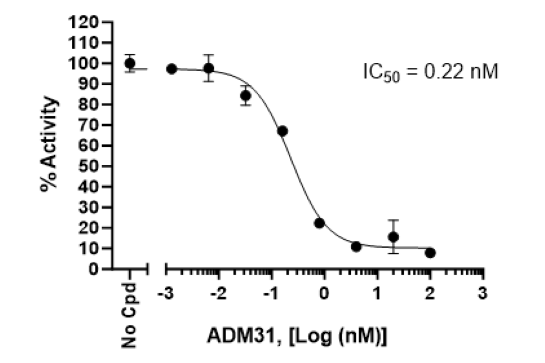HSA:FcRn Neutralizing Antibody Screening Chemiluminescence Assay Kit
The FcRn:HSA Binding Chemiluminescent Assay Kit is designed for screening and profiling neutralizing antibodies or blockers of the interaction between Human Serum Albumin (HSA) and human FcRn. This kit comes in a convenient 96-well format, with Biotinylated HSA and FcRn (FCGRT/B2M) (amino acids 24-297 of FCGRT and 21-119 of B2M), Streptavidin-HRP, and assay buffers for 100 reactions.
The assay requires only a few steps. First, FcRn is coated on a 96-well plate overnight. After blocking, the protein is pre-incubated with the neutralizing antibody or blocker. Upon subsequent incubation with Biotin-HSA, the plate is treated with Streptavidin-HRP followed by addition of an HRP substrate to produce chemiluminescence, which can then be measured using a chemiluminescence reader.
- PBS buffer (Phosphate Buffer Saline)
- PBST Buffer (1X PBS containing 0.05% Tween-20), pH 5.5.
- Luminometer or microplate reader capable of reading chemiluminescence
- Adjustable micropipettor and sterile tips
- Orbital shaker
| Catalog # | Name | Amount | Storage |
| Human Serum Albumin (HSA), Biotin-Labeled * | 50 µg | -80°C | |
| 71285 | FcRn (FCGRT/B2M), His-Tag* | 250 µg | -80°C |
| 78502 | Blocking Buffer 6 | 25 ml | +4°C |
| 5X FcRn Binding Buffer 2 | 1.5 ml | -20°C | |
| 79742 | Streptavidin-HRP | 10 µl | +4°C |
| 79670 | ELISA ECL Substrates A and B (2 components) | 6 ml each | Room Temp |
| 79837 | White 96-well strip microplate | 1 | Room Temp |
*The initial concentration of both FcRn and HSA is lot-specific and will be indicated on the tube containing the protein.
Neonatal Fc receptor for IgG (FcRn) is a heterodimeric protein. FcRn consists of the Fc Gamma Receptor and Transporter encoded by the FCGRT gene, associated with beta-2-Microglobulin (B2M). FcRn binds to the Fc region of monomeric immunoglobulin G (IgG). It is expressed in over 25 tissue types, with high expression levels observed in the spleen and intestine. In the placenta, it transports IgGs from mother to fetus. FcRn contributes to an effective humoral immunity by protecting IgGs from degradation, recycling them and extending their half-life in circulation. In addition to IgGs, it regulates the homeostasis of serum albumin. The function of FcRn can be exploited by engineering therapeutic antibodies to increase their binding to FcRn, thereby improving their half-life and therapeutic efficacy. For example, an antibody cocktail that contains Fc mutations and an extended half-life (Evusheld) is used to treat COVID-19. The first-in-class drug, Enbrel, a TNF-alpha/Fc fuses Fc portions to a therapeutic protein to increase their half-life. There are now several other drugs in clinical using similar strategies. Conversely, FcRn is a potential therapeutic target for autoimmune diseases. Disrupting the FcRn/IgG interaction is expected to increase the overall clearance of IgGs, including disease-causing autoantibodies. Engineered Fc fragments or neutralizing IgGs that bind to FcRn with high affinity through their Fc region are currently undergoing clinical trial. The first FDA-approved drug targeting FcRn (efgartigimod) is now used to treat myasthenia gravis, an autoimmune neuromuscular disease caused by the presence of autoantibodies against acetylcholine receptor, providing proof-of-concept in favor of this strategy.
Chaudhury C., et al., 2006 Biochemistry. 45 (15): 4983-90.
Dall'Acqua W.F., et al., 2002 J Immunol. 169(9): 5171-80.


